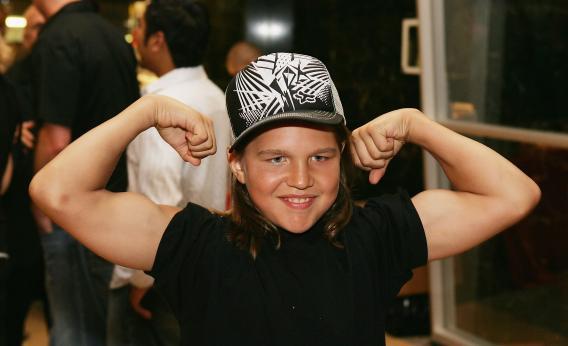Yet another way in which boys are apparently becoming just like girls: They are obsessed with their bodies, according to this front page New York Times story today. They are obsessed to an unhealthy degree. They count calories, drink weird powdery shakes instead of eating normal meals, take pills that alarm their pediatricians. We have thinness. They have “muscle enhancement.” We have the well-dressed skeletons in the H&M ads. They have The Situation, who, since rehab, lifts up his shirt a little less this season but still enough to make masses of American teenage boys jealous.
According to this new study in Pediatrics discussed in the Times story, boys surveyed in the Minneapolis-St. Paul area reported a record number of “muscle-enhancing behaviors,” which included everything from going to the gym to taking steroids. Two-thirds of the mostly middle school age boys were taking actions to increase their muscle size; 34.7 percent were drinking protein shakes and 5.9 percent were taking steroids. The diagnosis made by the researchers is just Beauty Myth in reverse: A “stark” increase in scantily dressed men in advertising (thank you, Marky Mark) and a bulking up of action figures has caused an epidemic of “body dissatisfaction and “muscle dysmorphia in young men,” the researchers write.
I’m sure that things have changed for teenage boys, around the edges. We have social media now, so boys can post Tumblr pics of their favorite ripped athletes under the heading “fitspo,” the Times story reports, which is a rip-off of the “thinspo” tag banned from many sites because it promotes anorexia. They can also post progress pics of their own workouts and their friends can judge. And maybe steroids are easier to get now—I have no idea. That said, I distinctly remember my brother being obsessed with Joe Weider protein shakes when we were teenagers in the ’80’s. And wasn’t Charles Atlas (“Hey Skinny! Yer ribs are showing!”) the original Situation back in the ’20s?
What’s mostly changed is how we frame the life cycle of boys. No one felt all that bad for Skinny in the 1920s because it was assumed that Atlas was mostly right: Skinny needed to learn how to be a man. Now, we seem to have woken up and discovered that young boys have a rich emotional life, that they struggle just like the girls do, that despite what Caitlin Flanagan writes, it’s not just girls spilling their agonies every night to their pony embossed diaries but also boys who think middle school sucks, too.
The worst outcome of this shift in perspective is we start bombarding boys with the same annoying mixed messages we’ve been throwing at girls all these years. (Get off the couch and stop playing video games! Wait, but don’t go to the gym!) The best outcome is we start breaking down some of the hoary old evolutionary biology stereotypes about how boys and girls behave around sex, and start believing that men too want partners who see them for who they are, and not just for their pretty abs.
